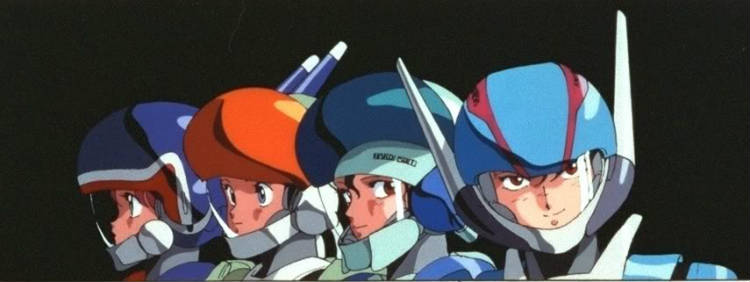Mala Educacion
East meets West: Anime & western film [part1]
| Bubblegum Crisis - "we originally named the series 'bubblegum' to reflect a world in crisis, like a chewing-gum bubble that's about to burst." [1]
Its well known the connections between Japan and the West [especially America], although few know the influences of western films on Anime or vice versa. The visual feast and engaging stories in certain Anime [Japanese animation] and Western films echo the works of science fiction writers and dystopian novelists from the recent past. This could prompt one to wonder if there's some unseen connection. A 1987 - 1991 OVA [original video animation] series, Bubblegum Crisis is Cyberpunk anime set in a high-tech future of Tokyo, created by Toshimichi Suzuki & Junji Fujita. Kenichi Sonoda designed the characters, Masami Obari created the mechanical designs and music by Koji Makaino. Powerful corporations & mega-corporations are hard-wired into most aspects of life, robots [or "Boomers", as their called] designed for military and domestic use often wreak havoc throughout the city. The ordered, futuristic streets, gleam with prosperity and purpose amidst over-industrialization, urban decay with overtones of excess. The stories revolve around a group of young female vigilante's, who use high-tech, armored suits to combat rogue boomers, and the individuals behind them. Justifiable violence to counter violence used as a vector towards power and control. Unlike some other anime or films, the women are portrayed in a strong, realistic way - as individuals [this may be from western influence]. Sylia Stingray [ the leader], Priss Asagiri [rebelious & stuborn. She is also the lead singer of "The Replicants" in her normal life], Linna Yamazaki [exercise & aerobic instructor], and Nene Romanova [Police officer]. Episode 1 ["Tinsel City"], opens with the camera panning in towards some buildings as a demolition explosion occurs, establishing the violence needed to create the future. As the scene moves to Priss getting ready for a gig, the music performances from Streets of Fire comes to mind. The energy of the crowd, vibe of the music, lighting and sudden charge is a sweet late-80's introduction to the madness of urban life. The main songs within the series are intoxicating and hard-hiting, [Mad Machine, Hurricane, & Burning Highway] carrying everything along. Each episode is accompanied with a song by Priss & The Replicants, which are in fact, real Japanese Rock & Pop bands. I wish they showed more performances of Priss and the Replicants [the word replicants may be from Blade Runner, which was released before the series was created]. The use of real music for a fictional band within a fictional story-line, is an interesting take on art imitating life. To this day I prefer to hear the music in Japanese [in English it's okay], it has a certain feeling and beauty that way. |
Its dark streets and cityscapes are reminiscent of Blade Runner; a massive, complex urban environment glows with power, while a cylindrical, pyramid-like structure looms over all. Buildings scrape the sky on the asphalt shores of eternity; amongst memories of green, and industrial decay. The cinematography and direction is quite good - even great at times given when it was made. There's subtly and care with the scenes, along with the violence as the stories unfold. Your not shown a city, so much as brought into one; a maddening silence in the night-time cityscape. The sense of pointlessness in a city drowning in technology, pollution, violence and corporate corruption. The humanoid robots ["Boomers"], whether serving an individual, corporation or computer program are powerful, destructive and have no remorse. One could sense the "Terminator" in this; the manifestation of man's violence turned on its creator, and or the general population. Created for practicality, yet they become impractical; dangerous pawns in a game where the rules change and human life has little value. Designed to serve society, they become savage instruments directed by shadowy individuals. In many ways Bubblegum Crisis was groundbreaking - its writing, character & Mechanical design, setting and moody feel. The use of female protagonist's is certainly worthy of praise. Cyber-crimes, power consolidated in the hands of mega-corporations, violent cyborgs and dystopian-slums echo the works of Harlan Ellison, Philip K Dick and others. Like a digital vine sprouting systemic, creative anomalies that force us to considers what our world is becoming, in light of what was written decades ago by fiction writers. 1. Toshimichi Suzuki in a 1993 interview for Animerica.
Kerwin Kendell Williamson Originally from Trinidad & Tobago, K.K.W (Kerwin K Williamson) started pursuing fine-art more intensely in 2001 while still working on his first comic/graphic novel (Land of the rising sun). By 2006 he had been accepting various freelance Illustration jobs and beginning to painting in abstract. In the summer of 2009 he began working in film-photography [black&white]. The urban setting of Brooklyn & Manhattan was his first subject, then moving into digital photography [ documenting art & music events] starting in 2011. He started writing about art, politics, and occasionally film at this time. While not a trained writer, he quickly showed a great deal of passion while improving is work. Studio-Phoenix blog spot is where most of his writing can be seen - started by him in 2011, featuring articles, interviews and photo's about emerging & mid-level creative individuals from different parts of the world. 'The way I see it, art encompasses everything; the way we live, dress, eat, think, feel, and interact with each other. Art is the reason, art is the way' |

